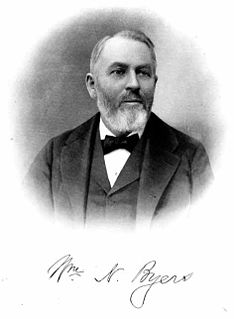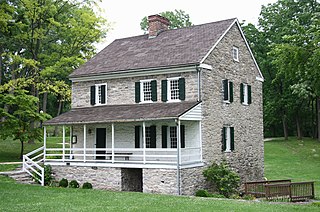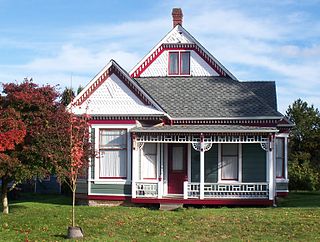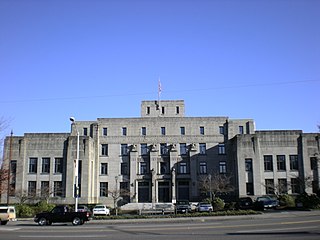
Corydon is a town in Harrison Township, Harrison County, Indiana. Located north of the Ohio River in the extreme southern part of the U.S. state of Indiana, it is the seat of government for Harrison County. Corydon was founded in 1808 and served as the capital of the Indiana Territory from 1813 to 1816. It was the site of Indiana's first constitutional convention, which was held June 10–29, 1816. Forty-three convened to consider statehood for Indiana and drafted its first state constitution. Under Article XI, Section 11, of the Indiana 1816 constitution, Corydon was designated as the capital of the state until 1825, when the seat of state government was moved to Indianapolis. During the American Civil War, Corydon was the site of the Battle of Corydon, the only official pitched battle waged in Indiana during the war. More recently, the town's numerous historic sites have helped it become a tourist destination. A portion of its downtown area is listed in the National Register of Historic Places as the Corydon Historic District. As of the 2010 census, Corydon had a population of 3,122.

Mount Auburn Cemetery is the first rural, or garden, cemetery in the United States, located on the line between Cambridge and Watertown in Middlesex County, Massachusetts, 4 miles (6.4 km) west of Boston. It is the burial site of many prominent Boston Brahmins, as well as being a National Historic Landmark.

William Newton Byers was a founding figure of Omaha, Nebraska, serving as the first deputy surveyor of the Nebraska Territory, on the first Omaha City Council, and as a member of the first Nebraska Territorial Legislature.

The Corydon Historic District is a national historic district located in Corydon, Indiana, United States. The town of Corydon is also known as Indiana's First State Capital and as Historic Corydon. The district was added to the National Register of Historic Places in 1973, but the listing was amended in 1988 to expand the district's geographical boundaries and include additional sites. The district includes numerous historical structures, most notably the Old Capitol, the Old Treasury Building, Governor Hendricks' Headquarters, the Constitution Elm Memorial, the Posey House, the Kintner-McGrain House, and The Kintner House Inn, as well as other residential and commercial sites.

Graeme Park is an historic site and National Historic Landmark at 859 County Line Road in Horsham, Montgomery County, Pennsylvania. It is owned by the Pennsylvania Historical and Museum Commission and operated by the non-profit group, The Friends of Graeme Park. It is the only surviving residence of a colonial-era Pennsylvania governor. Graeme Park was constructed in 1722 by Sir William Keith as a summer residence and alternative to his governor's mansion at Shippen House on Second and Spruce Streets in Philadelphia. The house, originally known as Fountain Low, has been largely unchanged since its construction except for a restoration by Dr. Thomas Graeme in the mid 18th century and a minor restoration by the Pennsylvania Historical and Museum Commission in the 1960s.

The history of Olympia, Washington, includes long-term habitation by Native Americans, charting by a famous English explorer, settlement of the town in the 1840s, the controversial siting of a state college in the 1960s and the ongoing development of arts and culture from a variety of influences.

Bigelow Neighborhood, also called the Bigelow Historic District, is a historic district located on the eastside of Olympia, Washington. It is located along Olympia Avenue, between East Bay Drive and Tullis Street.
Daniel Bigelow was a pioneer lawyer and politician in Olympia, Washington.

The Alexander Ramsey House is a historic house museum in Saint Paul, Minnesota, United States; the former residence of Alexander Ramsey, who served as the first governor of Minnesota Territory and the second governor of the state of Minnesota. It was listed on the National Register of Historic Places in 1969. It is also a contributing property to the Irvine Park Historic District.

The T.G. Richards and Company Store, also known as Whatcom County Courthouse and James B. Steadman Post No. 24, is the first and oldest brick building in the state of Washington, United States, and is listed on the U.S. National Register of Historic Places.

The Hager House is a two-story stone house in Hagerstown, Maryland, United States that dates to c. 1740. The house was built by Jonathan Hager, a German immigrant from Westphalia, who founded Hagerstown. The basement contains two spring-fed pools of water, providing a secure water source. Hager sold the property, then known as Hager's Fancy to Jacob Rohrer. The house remained in the Rohrer family until 1944, when it was acquired by the Washington County Historical Society. The restored house was given to the City of Hagerstown in 1954 and opened to the public in 1962 as a historic house museum.

The Frisco Depot and adjacent Antlers Spring are historic sites in Antlers, Oklahoma, United States. The sites are a part of the National Register of Historic Places, in which they appear as a single entry.

Virginia House is a manor house on a hillside overlooking the James River in the Windsor Farms neighborhood of Richmond, Virginia, United States.

The South End–Groesbeckville Historic District is located in part of the neighborhood of that name in Albany, New York, United States. It is a 26-block, 57-acre (23 ha) area south of the Mansion and Pastures neighborhoods with a mix of residential and commercial properties. In 1984 it was recognized as a historic district and listed on the National Register of Historic Places.

The Hale House, also known as the Hale Residence is located at 902 Tullis St, NE Olympia, Washington. The house is an American Queen Anne style Cottage and was built in 1882 for Captain Calvin Henry Hale and Pamela Case Hale. The house was placed on the National Register of Historic Places January 12, 1984.

The Comstock House is a historic house museum in Moorhead, Minnesota, United States. It was built for Solomon Comstock and his family from 1882 to 1883 in a mix of Queen Anne and Eastlake style. Comstock (1842–1933) was one of Moorhead's first settlers and an influential figure in business, politics, civics, and education in the growing city and state.

Calvin Henry Hale was an American settler in the Washington Territory who became involved in territorial government. In 1862 he was appointed Superintendent of Indian Affairs in the territory which included Washington and Idaho.
Benjamin Deyerle (1806–1883) was an architect, artist and brickmaker in Roanoke County, Virginia. Many of the historic homes, churches and public buildings in Roanoke were designed and built under his and his family's direction. He is credited with building 23 of them, and perhaps more. Some of these homes and buildings are currently listed on both the National Register of Historic Places and the Virginia Landmarks Register.

The Thurston County Courthouse in Olympia, Washington is the former headquarters of Thurston County. It was built in 1930 and has been listed on the National Register of Historic Places since 1981.



















